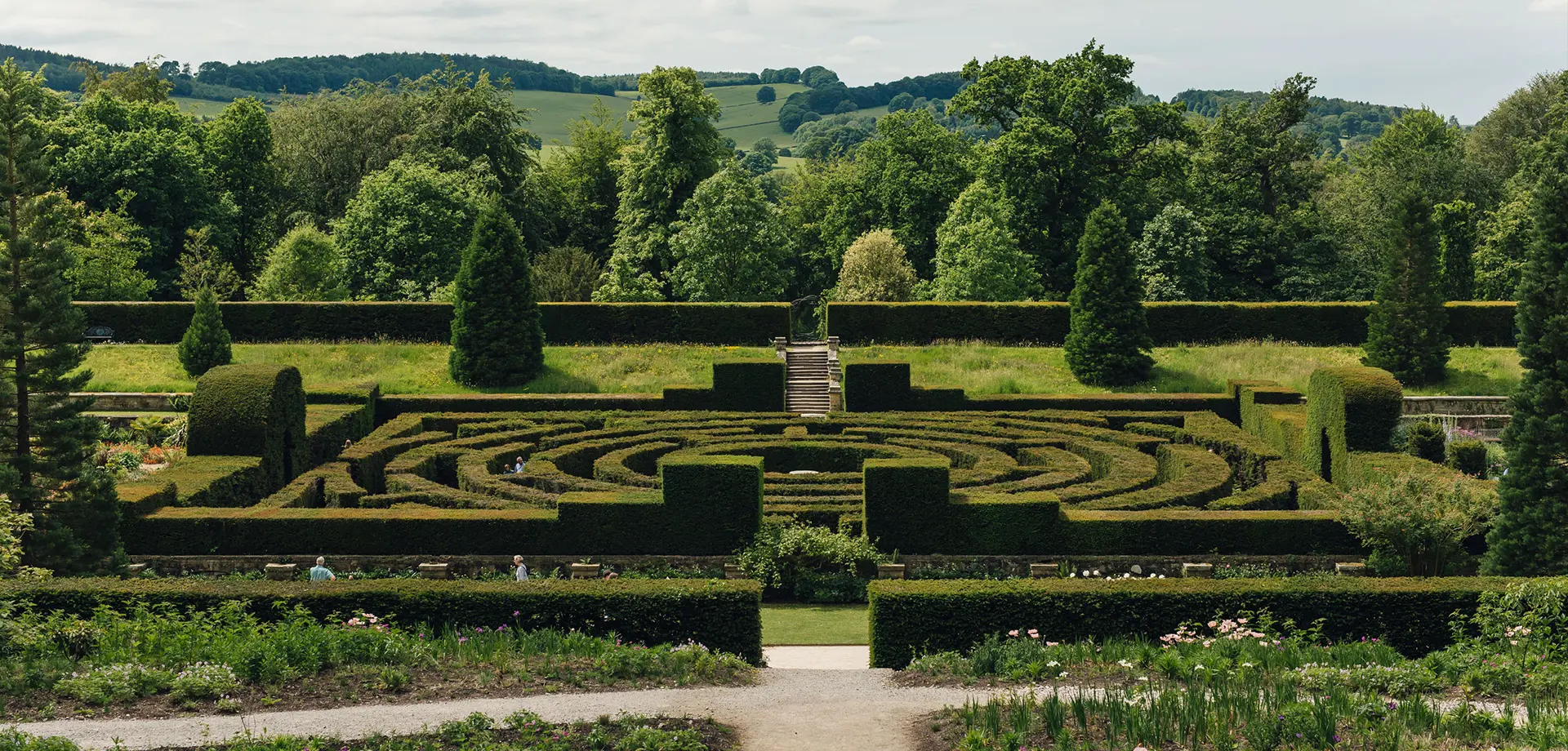Designed by Denis Fisher, the then Comptroller, in 1962 for the 11th Duke, 1,209 English yews, Taxus baccata, were required to complete the Maze.
In the 1920s flower beds were laid out at each end within the remaining walls of the Great Conservatory, with paths through and around them. The planting has changed but the beds remain. In the four central beds at the north end there are Russell hybrid lupins, Lupinus Russell Hybrids, and late summer and autumn flowers are planted in the beds that surround these. At the south end, the outside beds are planted with Michelmas daisies, Aster. The inner beds are interchanged with tulips in spring, and dahlias in late summer until the frosts.
During the 1980s, the Hundred Steps were created. This long, straight ascent runs uphill from the Maze and is aligned on the centre of the Maze. The Greek Altar, discovered by the then head gardener Jim Link and his team in the mid-1980s during clearance work, has been put at the top of the steps, on the Arboretum Walk, to encourage you to stop and look west, across the Maze to admire the park and surrounding woods.
Duchess Deborah had a human sundial installed (1990) at the north end of the Maze, after seeing one illustrated in a magazine. There is a flat stone with the names of the months cut into it. You stand on the relevant month and your shadow falls on the time of the day, which is engraved on bricks at the proper angle.
Discover more from the modern garden
Ravine and Azalea Dell
In the early 1930s, the 9th Duke’s wife, Evelyn, in collaboration with the head gardener, J. G. Weston, created the Ravine and the Azalea Dell in the south of the garden.
Rose Garden
Originally the French Garden, in 1939 Duchess Mary, wife of the 10th Duke, remodelled this area and it became known as the Rose Garden.
Serpentine Hedges
The Serpentine Hedges were created from an idea of Duchess Deborah's.
Display Greenhouse
This greenhouse is sited to the north of the First Duke's Greenhouse and has three climate zones: tropical, Mediterranean and temperate.
Kitchen Garden
Chatsworth has grown its own food for centuries and all manner of fruit, salad, cut flowers and vegetables are grown in the kitchen gardens.
Snake Terrace
In 1974, the Snake Terrace was constructed in the space between the First Duke's Greenhouse and the Display House.
Sensory Garden
The Sensory Garden was an idea instigated by Lord Burlington, the 12th Duke's son.
Quebec
In 2008, the 12th Duke and Duchess re-established Quebec, a long-over-grown area below the Canal Pond.
Summer House and Golden Grove
Near the Summer House is a plot planted in gold and yellow – the Golden Grove. All the shrubs and small trees here were given by friends and neighbours of the 11th Duke and Duchess to mark their golden wedding in 1991.
Cottage Garden
The Cottage Garden was created in 1989 with topiary 'rooms' and 'furniture' created out of box, privet and yew hedges.
Arcadia
The 12th Duke and Duchess, working with the Chatsworth Garden team and three celebrated garden designers, oversaw the biggest transformation of the garden for 200 years, including a brand new landscape project: Arcadia.
Learn about the early garden
The house and garden were first constructed by Sir William Cavendish and Bess of Hardwick in 1555. The Elizabethan garden was much smaller than the modern garden is now.
Discover the 6th Duke's Garden
The 6th Duke, working with renowned gardener Joseph Paxton, made radical and pioneering changes to the Chatsworth Garden and Estate.



